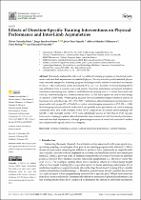Por favor, use este identificador para citar o enlazar este ítem:
https://repositorio.usj.es/handle/123456789/774
Registro completo de metadatos
| Campo DC | Valor | Lengua/Idioma |
|---|---|---|
| dc.contributor.author | Gonzalo-Skok, Óliver | - |
| dc.contributor.author | Sánchez-Sabaté, Jorge | - |
| dc.contributor.author | Tous-Fajardo, Julio | - |
| dc.contributor.author | Mendez-Villanueva, Alberto | - |
| dc.contributor.author | Bishop, Chris John | - |
| dc.contributor.author | Piedrafita, Eduardo | - |
| dc.date.accessioned | 2022-04-26T14:21:00Z | - |
| dc.date.available | 2022-04-26T14:21:00Z | - |
| dc.date.issued | 2022-01-18 | - |
| dc.identifier.citation | Gonzalo-Skok, O.; Sánchez-Sabaté, J.; Tous-Fajardo, J.; Mendez-Villanueva, A.; Bishop, C.; Piedrafita, E. Effects of Direction-Specific Training Interventions on Physical Performance and Inter-Limb Asymmetries. Int. J. Environ. Res. Public Health 2022, 19, 1029. https:// doi.org/10.3390/ijerph19031029 | es_ES |
| dc.identifier.issn | 1660-4601 | es_ES |
| dc.identifier.uri | https://repositorio.usj.es/handle/123456789/774 | - |
| dc.description.abstract | This study analyzed the effects of two different training programs on functional performance and inter-limb asymmetries in basketball players. Twenty-four elite youth basketball players were randomly assigned to a training program including variable unilateral horizontal movements (VUH, n = 12) or unilateral lateral movements (VUL, n = 12). Eccentric-overload training (EOT) was performed twice a week for a six-week period. Functional performance assessment included a countermovement jump test, unilateral multidirectional jumping tests (i.e., lateral, horizontal, and vertical), a rebound jump test, a limb symmetry index, a 25 m linear sprint test, and several change of direction (COD) tests. Within-group analysis showed substantial improvements in almost all functional tests in both groups (ES = 0.35-0.89). Furthermore, almost all jumping asymmetries were improved in both groups (ES = 0.38-0.69) except for vertical jumping asymmetry in VUL (ES = -0.04). Between-group analyses showed a substantial and possibly better performance in vertical jumping asymmetry and 5 m in VUH compared to that of VUL, respectively. In contrast, lateral jumping with left (ES = 1.22) and right leg (ES = 0.49) were substantially greater in VUL than in VUH. Specific force-vector training programs induced substantial improvements in both functional performance tests and inter-limb asymmetries, although greater improvements of lateral and horizontal variables may depend on the specific force vector targeted. | es_ES |
| dc.format.extent | 13 p. | es_ES |
| dc.format.mimetype | application/pdf | es_ES |
| dc.language.iso | eng | es_ES |
| dc.publisher | MDPIST ALBAN-ANLAGE 66, CH-4052 BASEL, SWITZERLAND | es_ES |
| dc.relation | This work was supported by "Research fellowship Universidad San Jorge Fundación, Banco Sabadell". We acknowledge Fernando Hernandez-Abad for his excellent drawings. | es_ES |
| dc.relation.requires | Adobe pdf | es_ES |
| dc.rights | Atribución 4.0 Internacional | * |
| dc.rights.uri | http://creativecommons.org/licenses/by/4.0/ | * |
| dc.subject | Resistance | es_ES |
| dc.subject | Trainingeccentric | es_ES |
| dc.subject | Overloadfunctional | es_ES |
| dc.subject | Performancevariable training | es_ES |
| dc.title | Effects of Direction-Specific Training Interventions on Physical Performance and Inter-Limb Asymmetries | es_ES |
| dc.type | info:eu-repo/semantics/article | es_ES |
| dc.relation.publisherversion | https://www.mdpi.com/1660-4601/19/3/1029 | es_ES |
| dc.identifier.publicationfirstpage | 1 | es_ES |
| dc.identifier.publicationlastpage | 13 | es_ES |
| dc.identifier.doi | 10.3390/ijerph19031029 | es_ES |
| dc.rights.accessrights | info:eu-repo/semantics/openAccess | es_ES |
| Aparece en las colecciones: | Artículos de revistas | |
Ficheros en este ítem:
| Fichero | Descripción | Tamaño | Formato | |
|---|---|---|---|---|
| Effects of Direction-Specific Training Interventions.pdf | 1,19 MB | Adobe PDF |  Visualizar/Abrir |
Este ítem está sujeto a una licencia Creative Commons Licencia Creative Commons

